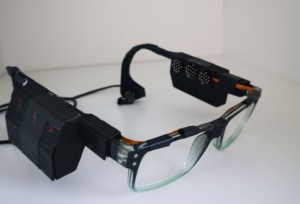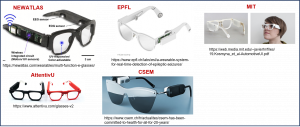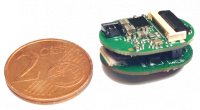Difference between revisions of "Advanced EEG glasses"
From iis-projects
| Line 61: | Line 61: | ||
[[Category:Epilepsy]] | [[Category:Epilepsy]] | ||
[[Category:SmartSensors]] | [[Category:SmartSensors]] | ||
| + | [[Category:EmbeddedAI]] | ||
Revision as of 15:25, 23 October 2023
Contents
Short Description
Electroencephalography (EEG) is a commonly used clinical tool to analyze brain activity. Applications of EEG span from the development of brain-computer interfaces (BCI), to the monitoring and detection of epileptic seizures. The golden standard is represented by scalp-EEG systems, consisting of caps equipped with multiple electrodes positioned on the scalp. However, these systems are cumbersome and make the users uncomfortable because of perceived stigmatization. Thus, both patients and caregivers would benefit from the availability of wearable long-term EEG monitoring devices. One possible approach is to place a reduced number of electrodes in minimally intrusive devices, such as glasses [Sopic et al., ISCAS, 2018]. At IIS, we developed an initial version of EEG-glasses powered by the BioGAP data acquisition platform [Baumgartner, BA thesis, 2023] The project will build up from the existing prototype to increase its robustness and signal quality for lont-term use.
Goal & Tasks
The goal of this project is to redesign the existing IIS EEG-glasses with enhanced robustness and reduced form factor. The students will explore the optimal positioning of electrodes and will design dedicated amplification PCBs with minimal form factor to be hidden in the glasses frame. Electrical-mechanical codesign (of PCBs and mechanical structure) will be paramount for the success of the project. Finally, Characterization experiments will be performed to demonstrate the functionality.
The main tasks of this project are:
- Literature study of EEG
- Testing of sensors and interfaces for optimal positioning
- PCB design of a form-factored board, embeddable in eyeglasses stems
- Firmware development for EEG data acquisition and processing
- Mechanical prototype design and sensor integration
Prerequisites
- basics of embedded C
- basics of PCB design
Literature
- [1] Sopic et al., ISCAS, 2018
- N. Baumgartner, "E-Glasses for Wearable and non-stigmatizing EEG Monitoring", ETH Bachelor Thesis, 2023
Status: Available
- Looking for Semester and Bachelor Students, the project can also be implemented in a collaborative way between multiple Bachelor students
- Supervision: Sebastian Frey Andrea Cossettini, Simone Benatti
Character
- 10% Literature Study
- 25% System assembly design
- 25% embedded system programming
- 25% PCB design
- 15% experiments and characterization


